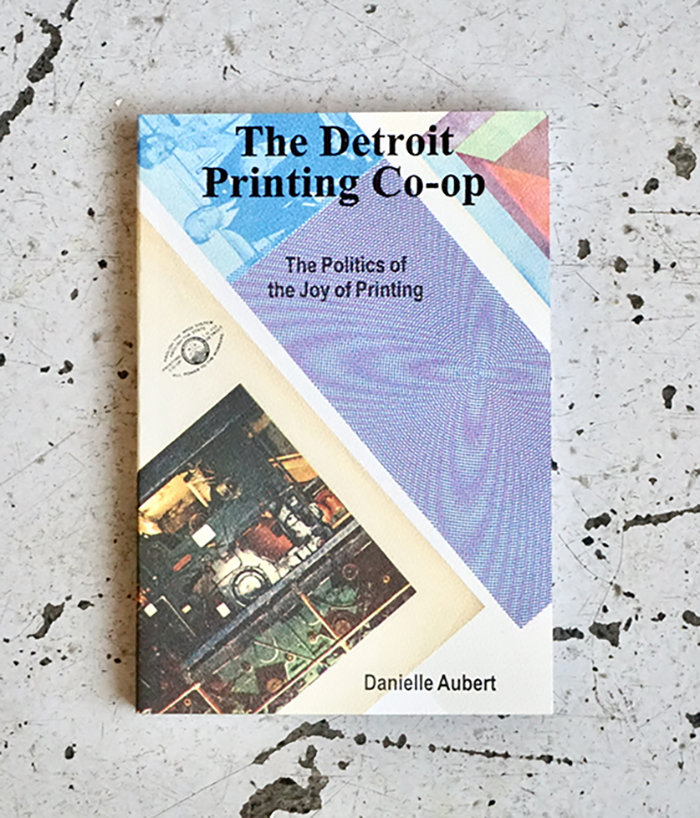
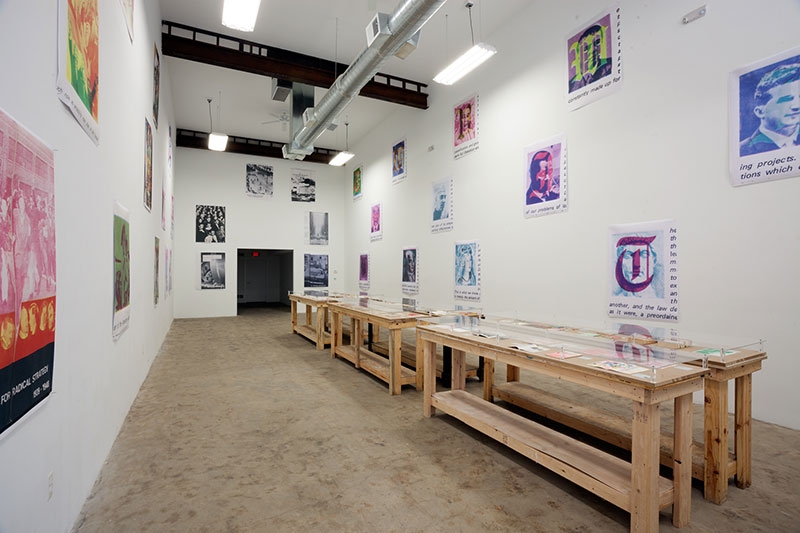
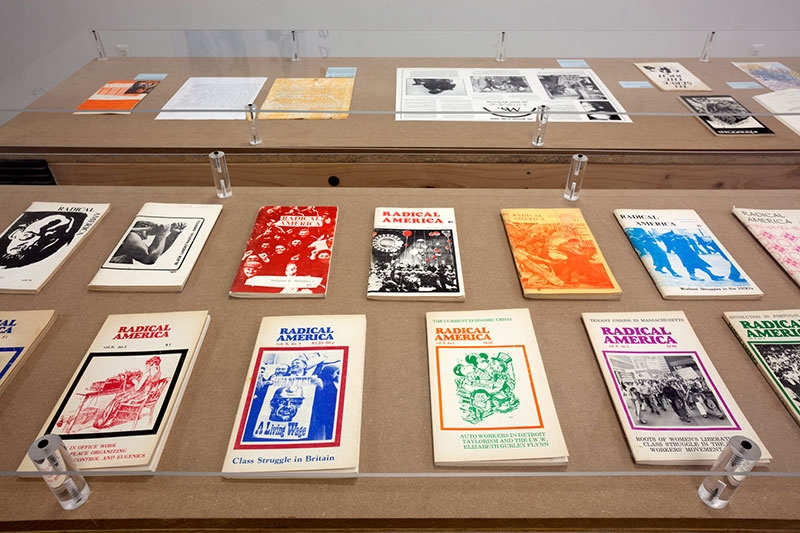
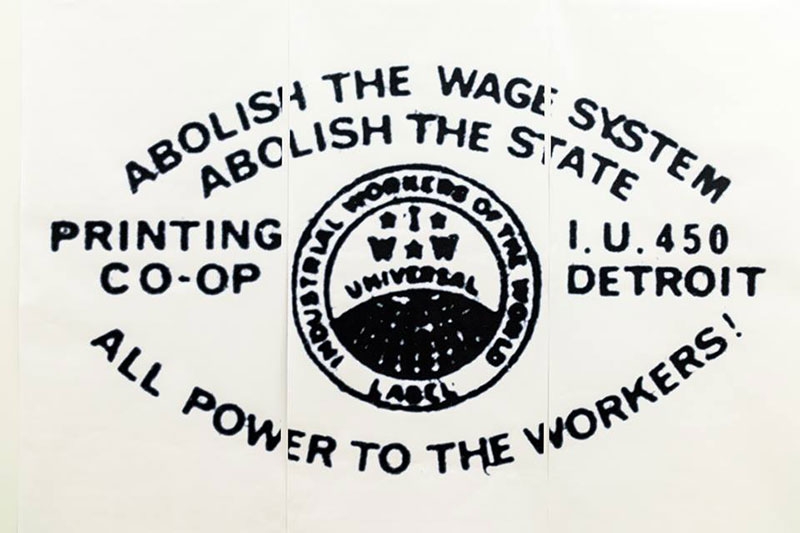
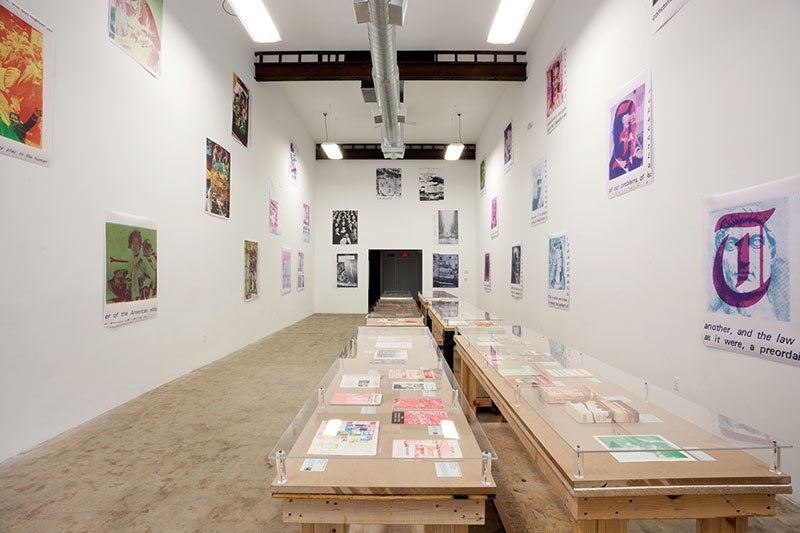
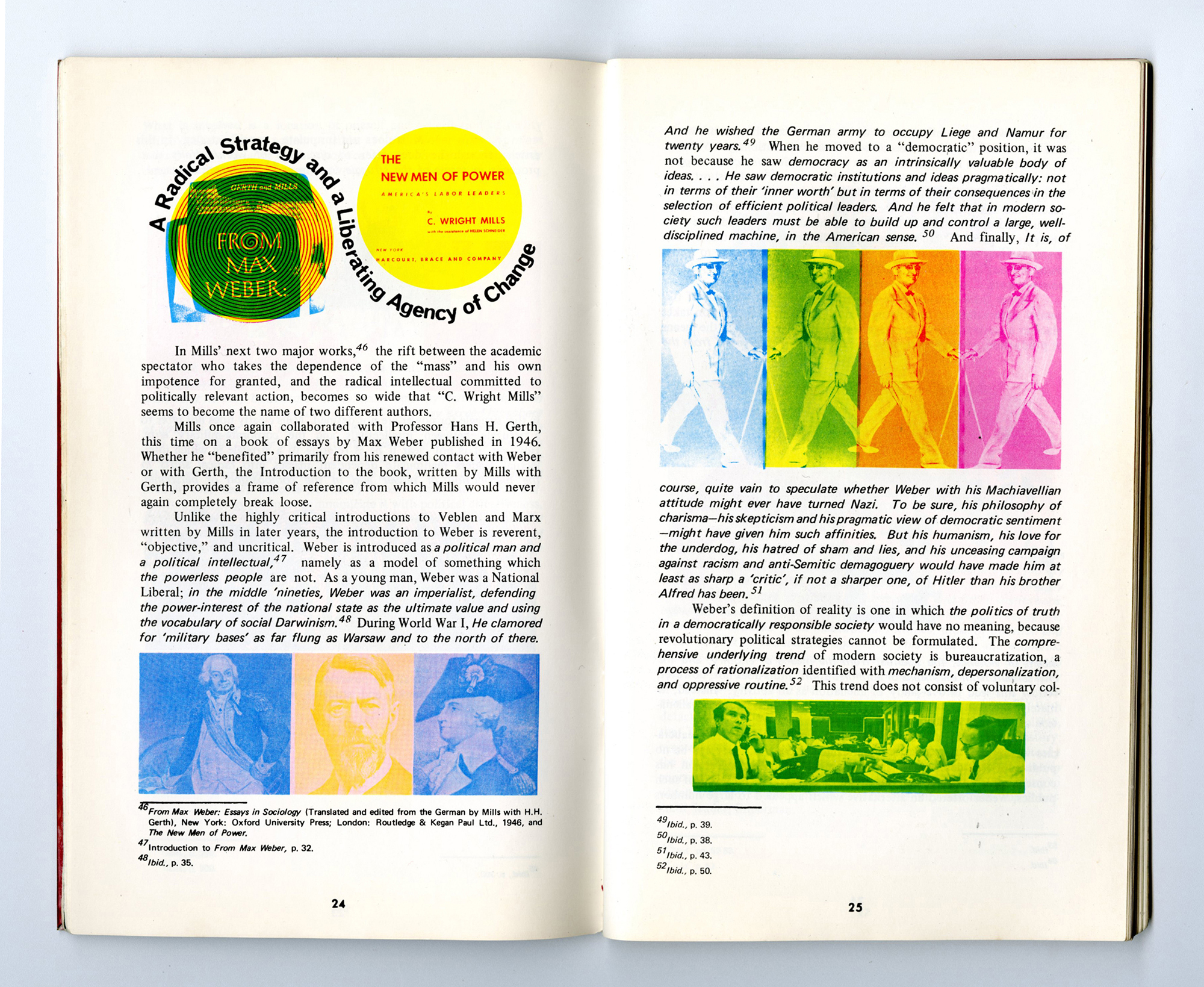
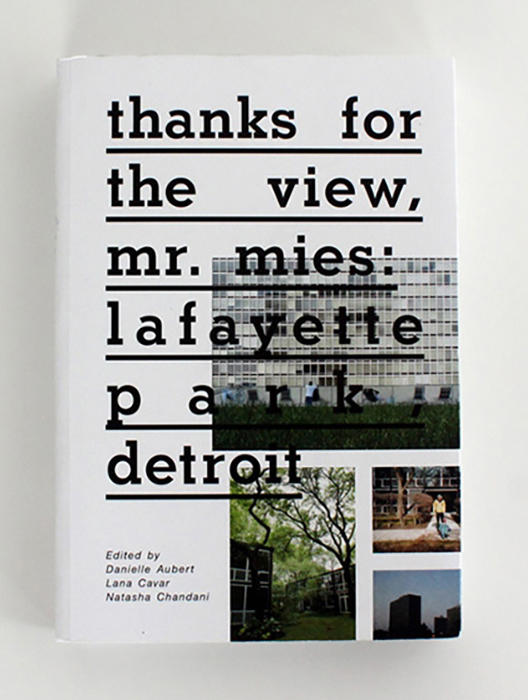
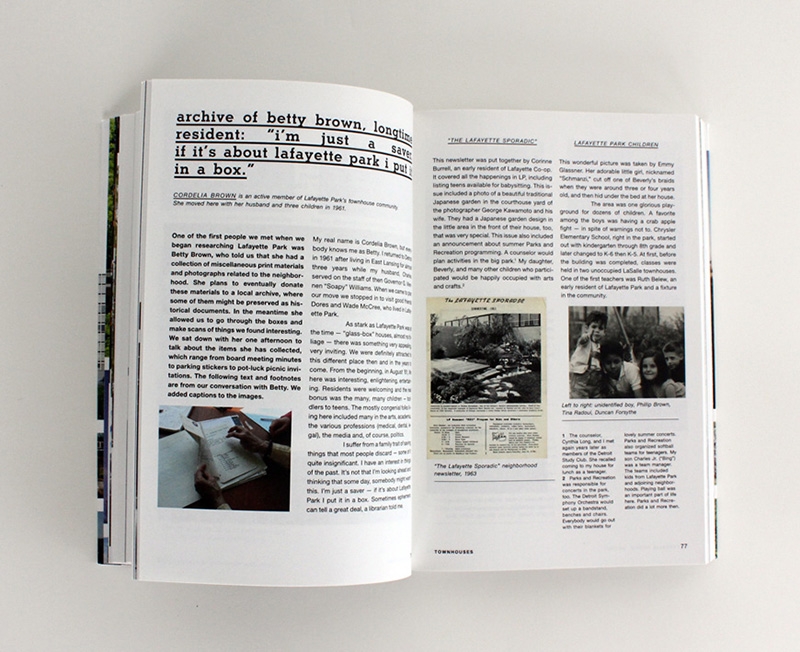
Danielle Aubert is a graphic designer and educator based in Detroit, Michigan. She holds a BA in English Literature from the University of Virginia, and practiced design in Moscow and New York City before completing an MFA in graphic design at Yale. Danielle has served on the board of the AIGA and was a Princeton Arts Fellow from 2013 to 2015. She is currently an Associate Professor in the Art and Art History department at Wayne State University where she’s taught since 2008.
Danielle has designed publications and print material for clients in the arts and academia, and much of her work is focused on materials, methods of production, machines and labour. In 2012, she co-authored Thanks for the View, Mr. Mies (Metropolis Books), a book about life in the Lafayette Park neighbourhood of Detroit. Her recent project, The Detroit Printing Co-Op (Inventory Press, 2019) is a history of a leftist printing press that published books and other material throughout the 1970s. library library spoke with Danielle in April 2020 about printing, politics, and her work as a design educator.
l.l. Your recent project, The Detroit Printing Co-op, explores the history of a non-profit printing outfit that produced tens of thousands of leftist books, pamphlets, posters and brochures from 1969 to 1980. The book tells the story of the Co-op’s founders, Fredy and Lorraine Perlman, and features many of the books, posters, student papers and other ephemera produced there, including the first English translation of Guy Debord’s Society of the Spectacle.
The Detroit Co-op was founded at a time when most mainstream presses in the United States refused to print left-wing publications. The Co-op provided an alternative to writers, activists, intellectuals and artists on the left looking for a place to publish their work. Those who participated in the Co-op saw publication as a political act, and understood the revolutionary potential of the printed page.
Today, the Internet is the most obvious and immediate platform for the dissemination of revolutionary political material. Print, however, is not yet dead. Are there any features of collaborative print production (like the model practiced by the Co-op) that can’t be replaced by today’s digital self-publishing tools? If so, what aspects of the Co-op’s production model do you think are still relevant today?
DA: One aspect of print production that is rarely replicated in digital publishing is the collective aspect of the work. Co-op users talk about how the act of assembling publications was often collaborative, but even if it wasn’t, it involved people working alongside one another doing various tasks — printing, collating, packing, moving paper around, making plates, working at the light table, etc.
Even when you’re working collaboratively in digital publishing, the tasks tend to be solitary. The writing, editing, designing, posting to a website all happen in different spaces.
One way in which the Co-op production model is relevant today has to do with Co-ops themselves as a formation. It could be interesting to consider how a design studio might operate as a co-op. Many small studios may already operate this way, with all members having an equal share in the business. What was interesting about the Co-op though was that they were members of the IWW (Industrial Workers of the World), and they were opposed to wage labor of any kind. The IWW prohibits hiring others — you couldn’t be in the IWW and be someone else’s boss. So that extends to things like not hiring a cleaning person to clean your space, and not ‘contracting out’ parts of the production. Anyone who worked at the Co-op did so of their own free will, not due to a motivation to be paid.
l.l. Although very few of the Co-op’s users (including the founders themselves) had any formal training in typesetting or the graphic arts, many of the publications produced at the site exude a joy for the craft of print through experimentation with overprinting and collage techniques, expressive typesetting, and an interest in materiality conveyed through paper choices. Can you speak about the importance of visual form and materiality in the work produced at the Co-op? What was, in your opinion, the relationship between aesthetics and politics there?
DA: There was a small group that used the Co-op that was connected with local visual and literary artists — they published three issues of a journal called riverrun. But for the most part, the Co-op users were not connected to the visual arts and cultural spheres in the Detroit area (though several did become involved with a performing arts space in the mid-1970s). That is not to say that they were not interested in aesthetics. Fredy Perlman, one of the main users of the Co-op, was influenced by William Blake, and sought to bring imagery into a lot of his early publications. He was committed to the idea of craft, and that texts could, and should, be beautiful and engaging objects. He was largely self-taught in this respect though. He played with collage, cutting and pasting, and weird color separations.
Much of the paper that they used at the Co-op was remaindered stock that had been rejected somewhere else, or was cheap for some reason. Many of the publications that came out of the Co-op use different kinds of paper stock for the same volume. Nearly all their publications are roughly the same size, and this was determined by the size of the offset press they used. In the early years of the Co-op they tended to favor setting type in Univers, which they thought of as a modern looking typeface (and, perhaps more importantly, had access to on the typesetting machine they used).
l.l. Your own body of work includes a travelling exhibition of discarded letterheads (Center for Abandoned Letterhead), a book featuring thousands of readers’ marks extracted from 100 copies of the paperback novel, Marking the Dispossessed, a collaborative performance piece that translates a John Cage score into thousands of graphic pages, each passed through several printers (Continuously Festive), and an archive of scrap paper in the form of a blank book series (Paper Rehabilitation Project).
You describe an interest in “materials, methods of production, machines and labor”, and many of your projects are closely connected to paper as well as the processes and byproducts of print production.
Paperback books, photocopied documents, letterheads, and scrap paper are not generally appreciated for their material value or aesthetic beauty. What is it about these seemingly mundane, low-resolution, mass-reproduced artifacts that you find interesting or meaningful?
DA: Thanks for this question — I think one reason I’ve often been interested to laser printers and ‘office paper’ is because I see this as a site of labor (“office work”) where there can be a lot of creative expression. For white collar workers, this is where surplus value is extracted, and where many find themselves bored or under utilized. I’ve gradually become more explicitly engaged with left politics over the years, so when I did the project around Ursula K. Le Guin’s book, The Dispossessed, it was partly an effort to grasp some of the principles of anarchist thought but also make it somehow about book publishing and graphic design.
l.l. You identify as a graphic designer, however much of your work involves serious research, writing and editing. You’ve also worked on several projects that seem much closer to fine art than traditional commercial graphic design. Is your decision to call yourself a “graphic designer” political in any way? In your opinion, how is graphic design different from fine art?
DA: This is an interesting question, I was just talking about this with a friend the other day. In my twenties, I spent a lot of time not knowing exactly how to describe myself, and I was uneasy not having a ‘title’ or descriptor for myself. When I finally started working in offices as a graphic designer, then later freelancing, I was relieved to be able to confidently call myself a graphic designer. Nowadays I more often lead with the fact that I teach graphic design, and I think this gets me out of the sort of awkwardness of trying to explain that I focus more on research. I do appreciate the connection between graphic design and office work. And I feel like graphic designers occupy the space of ‘skilled labor’ more than artists do.
l.l. You gave courses as a Princeton Arts Fellow from 2013 to 2015, and are an Associate Professor in the Art and Art History department at Wayne State University where you’ve taught since 2008. I would be curious to hear how your work as an educator informs the rest of your design practice.
DA: The biggest way that being employed at Wayne State informs my work has to do with the structure of being an academic. Wayne State is a research institution, and I receive support for doing the kinds of research projects I’ve been engaged with over the last several years. As far as actual engagement with students, I tend to keep those spaces a bit more separate. But that is mainly because I teach almost exclusively undergraduate students. This semester, for instance, I’m teaching History of Graphic Design, Introduction to Graphic Design and a course simply called Graphic Design 2. My task at Wayne State is to prepare my students professionally so that they can apply for jobs and potentially have careers as graphic designers. When I have had the opportunity to work with graduate students (we do get some now and again at Wayne) it’s been extremely rewarding, because I feel like I can actually work with them on research.
l.l. How is teaching at Wayne State, a public university in Detroit, different from your experience teaching at Princeton, a private Ivy League university?
DA: As I’m sure you can imagine, these two schools are about as different as you can find. Wayne State is a mostly commuter campus, whereas Princeton is a place where campus life is a key part of a students’ experience. One of the biggest differences is that Princeton is such a well-resourced place that funding was available for pretty much anything we wanted to do. I remember taking students on a field trip and the people in the office rented a van (with a driver!) for us without batting an eye. At the end of the semester there was funding available for each student to print a book.
At Wayne State, we never seem to have funding for much. It’s much scrappier, but when I first returned from Princeton I found I was a bit happier because I felt myself to be extremely useful. At Princeton it felt like there were seven staff members doing the job of every one person at Wayne State. At Wayne, I feel like I’m in constant motion—tidying things, cleaning, talking to students, checking on supplies, etc. We have a big program with about 120 majors, and only 3 full-time faculty. At Princeton, I never really knew what happened to our trash, it just disappeared. There were two graphic design majors (they were in the process of creating something of a course of study so it was a very new field to be teaching there).
Detroit is very poor, Princeton, NJ is very rich. I read this week that the mortality rate for COVID-19 patients here now exceeds that of New York. Detroit has experienced years of disinvestment, environmental racism (rates of cancer, heart disease and asthma are very high): the water shut-offs have been devastating for many families, we had a giant incinerator on the East side that finally was shut down this year, there is toxic dumping also on the East side, and we had massive “pet coke” piles on the edge of the Detroit river that blew black dust into the Southwest parts of the city. I could go on and on. In Princeton, students and faculty often talked about being inside an “orange bubble” (orange is their school color). Wayne State feels more connected to the city of Detroit — the campus is pretty porous, you can easily walk into most buildings, and it feels integrated within the city.
l.l. Because library library is a project that uses graphic design as a medium (and excuse) to have conversations arount literary texts, we'd like to ask you if there are any books you’ve read recently that you’d like to share.
DA: I hate to admit that I haven’t been reading many books lately, maybe partly due to the chaotic nature of the world right now! Over the last several years I have become increasingly involved in political organizing, and that is where I devote a lot of my mental energy. I’m semi-engaged with a Capital reading group, so the most recent book I’ve been reading is probably Marx’s Capital. Though I’ve definitely fallen behind, I’ve been intending to read Chapter 15, “Machinery and Modern Industry” because according to my friends in the reading group, this is very relevant to the Detroit Printing Co-op and other machine-interests. The other most recent book I was reading was Bernie’s Our Revolution. I’m kind of embarrassed to admit that only because it’s probably ghost-written I guess? It’s not highbrow literature. But I was involved with some local races for City Council with comrades from the DSA (Democratic Socialists of America). We lost, but another friend recommended Bernie’s book and in particular his accounts of losing local races in Vermont before finally winning.
A book that has impacted me the most in recent years is Jane McAlevey’s No Shortcuts: Organizing for Power in the New Guilded Age. McAlevey is a labor organizer who makes the case for militant, activist union organizing. She argues that a strong left movement is dependent upon strong labor, and that building a labor movement requires slow, steady, one-on-one organizing. Not long after reading this book, I also read Secrets of a Successful Organizer, which is published by Labor Notes. I’ve become more active in my union at Wayne State as a result, and I see the organizing in DSA as something I try to do in tandem with union organizing. I think graphic designers (or anyone) interested in left organizing could learn a lot from reading both of these last two books.
Back to top ↑